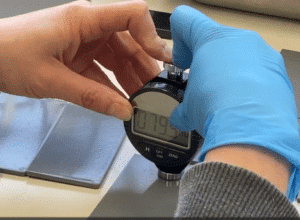ASTM D2240
Standard Test Method for Rubber Property—Durometer Hardness
Welcome to our ASTM D2240 testing services page for evaluating “Shore hardness” as part of our analysis of plastics and polymers. This standard, ASTM D2240, also known as “Rubber Property—Durometer Hardness,” allows for the measurement of a material’s hardness by indenting the material with a standardized tip under a defined force. The depth of indentation is proportional to the Shore hardness and ductility of the material as well as the geometry of the indentation tip used.
ASTM D2240: Shore Hardness Testing for Plastics and Polymers
The ASTM D2240 test involves pressing the indentation tip against the material to be characterized. The hardness is then read directly on the device’s scale. This testing method is frequently used to test composites and polymers and is often employed in accelerated aging tests to monitor the evolution of mechanical properties in relation to exposure. Other tests, such as measuring tensile strength and elongation, can also be used. However, one of the advantages of Shore hardness is that it is non-destructive.

Utility and Advantages of ASTM D2240
ASTM D2240 allows for the measurement of initial hardness or indentation hardness after a given time. The test involves applying a constant force without impact and then measuring the hardness. A total of twelve hardness scales are used without a mathematical link between increments; they are simply arbitrary. However, it is important to determine the appropriate scale based on the laboratory.
This test offers several significant advantages, including:
- Precise evaluation of material durability and strength.
- Assistance in selecting the optimal material for your specific needs.
- Compliance with international standards, ensuring global recognition of your products’ quality.
Materials Testable to ASTM D2240
The ASTM D2240 test is used to measure the hardness of various materials, mainly elastomers, plastics and other polymers. This standard ensures that they meet the hardness specifications required for their intended application, which is crucial for performance, safety and customer satisfaction. Here is a list of materials commonly tested using ASTM D2240:
Here is a list of materials commonly tested using this standard:
- Natural and synthetic rubber: Shore hardness testing is often used to test the hardness of rubber, whether used in tires, seals, hoses or other rubber products.
- Thermoplastic elastomers (TPEs): Combining the properties of rubber with the ease of thermoplastics processing, these elastomers can also be evaluated for hardness using ASTM D2240.
- Plastics: Some softer plastics can be tested using the Shore A scale, while harder plastics are often evaluated using the Shore D scale.
- Silicones and silicone gels: Used in a variety of medical and industrial applications, silicone-based materials are tested for hardness to ensure that they meet the specifications required for their intended use.
- Polyurethanes: Polyurethanes can vary considerably in hardness, from very soft materials to very hard plastics, and are therefore rated on different Shore scales according to their hardness.
- Vinyl: Flexible vinyl used in flooring, clothing and other applications can be tested for hardness and durability.
- Nitrile rubber, EPDM (ethylene propylene diene monomer) and other specialty rubbers: These materials are evaluated for hardness to determine their suitability for specific applications, such as chemical-resistant gaskets and hoses.
- Foams and foams: Foams used in packaging applications, seating and other areas are also tested for hardness to assess their ability to absorb shock and hold their shape.
ASTM D2240 Parameters and Implementation for Accurate Testing
- Initial hardness or timed hardness? (Initial hardness is most common)
- Sample geometry: Flat and homogeneous (without texture)
- Durometer scale to use: The most commonly used durometer scales are “A” and “B.” These two scales combined cover the hardnesses of rubbers to nylons.
- Number of samples or products: 1 sample, 5 measurements
- Sample size: 2″ X 2″ or larger with a minimum thickness of 0.64 mm (0.025 in.)
- Conditioning and testing temperature: 23 ± 2°C
- Conditioning and testing humidity: 50 ± 5%
ASTM D2240 Testing in Action
Watch our video about the ASTM D2240 Standard Test Method for Shore Hardness. It shows how we measure the depth of penetration of a specified type of indentor into soft materials like rubber or plastic.
Customized Services for Optimal Results with ASTM D2240
At Micom, we recognize the uniqueness of each project. Our team of experts is ready to guide you in choosing the parameters for conducting the tests and interpreting the results. We offer personalized support at every step of the process to ensure optimal results.
Ready to take advantage of ASTM D2240 to improve the reliability of your products?
Take action today. Contact our team today to discuss your specific needs, get detailed information on our services and plan your next steps towards more durable, high-performance products. If you have any questions, we’ll be happy to answer them too.
Exploring Related Methods
As mentioned earlier, hardness measurement can be used for compliance purposes or to monitor a material’s reaction to an accelerated aging process, for example, ASTM G154 or ASTM F1980. Other methods can also be used to characterize materials, but they have the disadvantage of being destructive, including ASTM D412 and ASTM D638.
Explore Micom’s Full Range of Polymer Testing Services
For additional test methods related to this standard, we invite you to read about polymer testing and ASTM testing. You can also download our brochure to learn more about our paint, coating and polymer testing services.


